|
[Front Page] [Features] [Departments] [Society Home] [Subscribe]

Eremophila: The Emu Bush
Colin Jennings
This article was originally published in 1997.
For updated information on the species and their propagation see the ANPSA Eremophila Study Group webpages. These pages include recent newsletters from the Study Group and an image gallery showing all 236 described species (as at mid-2020) and a number of registered cultivars and hybrids. |
The family Myoporaceae is found to be concentrated in Australia in the semi-arid and arid regions, being found in all mainland states and the Northern Territory. The largest number of species is located in Western Australia; the greatest density being in the Eremaean Botanical Province, centred on the Willuna area. It is represented by two genera, Eremophila R. Br. and Myoporum Sol. ex Forster f..
Eremophilas have been used in Aboriginal tribal life in both cultural and medicinal roles. Plant material has been used in ceremonial rites, extracts and decoctions of plant parts have been used as liniments, medicines and antiseptics. The resinous exudants from some species, being used as sealants and adhesives. (Richmond 1993).
Currently 214 species of Eremophila are recognised, some 70 or so are to be published in the near future, in addition, approximately 50 subspecies will be validated. (Chinnock pers. comm. 1997).
Approximately 75% of eremophilas are insect pollinated (entomophilous), with the remainder being bird pollinated (ornithophilous).
Eremophila species are locally dominant in many areas, often growing in impoverished sites; in general they are tolerant of harsh conditions, including drought, fire, frost, flooding and grazing - the name Poverty Bush being aptly applied. In addition to this name, they may also be referred to as Emu Bush, Fuchsia Bush, Tar or Turpentine Bush. Common names applied to particular species are many and varied, whilst Aboriginal people have names for plants which they use.
In 1968, at the suggestion of Rex Kuchel of the Adelaide Botanic Garden, Margaret Lee of SGAP (SA Region), started a group of enthusiasts under the banner "Project Eremophila", which in 1972 became the Eremophila Study Group. Its members have been instrumental in pioneering the introduction of many species into cultivation. In their September, 1973 Newsletter, number 3, they list 63 species in cultivation, many of which were very new, and described in the Newsletter as very small; too small for cuttings to be taken for members.
Select a thumbnail image or highlighted name for a higher resolution image.
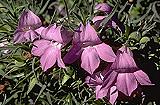
Eremophila spectabilis (47k)

Eremophila biserrata (23k)
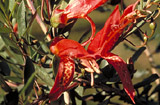
Eremophila maculata (29k)
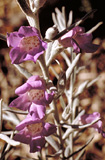
Eremophila nivea (28k)

Eremophila psilocalyx (37k)
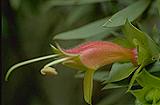
Eremophila duttonii (19k)

Eremophila mitchellii (37k)
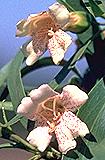
Eremophila bignoniflora (33k)
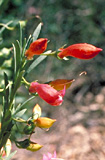
Eremophila racemosa (26k)
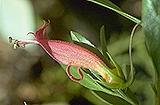
Eremophila denticulata (22k)

Eremophila latrobei (26k)
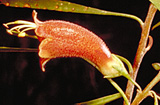
Eremophila longifolia (23k)
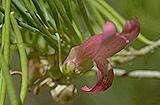
Eremophila alternifolia (21k)
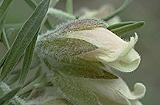
Eremophila eriocalyx (20k)
|
|
In the early 1980s, Ray Isaacson of Geranium, South Australia, showed that grafting eremophilas onto Myoporum rootstock was possible and from his humble start this process has become the norm for establishing newly introduced species and for extending the range of species which can be grown in the more temperate areas.
Eremophilas are diverse in their habit, ranging from prostrate groundcovers, like E.serpens and E.biserrata, to shrubs, both small and large, e.g. E.glabra, E.maculata and E.nivea to large bushes including E.psilocalyx, E.gibsonii and E.duttonii. There are several tree species, including E.mitchellii, E.longifolia and E.bignoniiflora. Flowers range in colour across the spectrum, as well as white.
A survey carried out in 1995/96 by the Eremophila Study Group revealed that there were 165 species being grown by members of the Group, some tenuously so, but others growing extremely well and now fully established as plants with horticultural merit. It is very pleasing to note that many of the species gazetted as Rare and Endangered, including E.nivea, E.racemosa, and E.denticulata are now well known as garden plants.
My observations in nurseries in South Australia and Victoria indicate that there are about 20 or so species available through general nurseries, with about 80 available through those which specialise as native nurseries. There are now many colour forms marketed and it is noted that the 'colour' labels attached to so many plants these days often have concocted names which are not registered with the Australian Cultivar Registration Authority. This will, I fear, lead to much confusion in the future.
Cultivation and Uses
The cultivation of eremophilas is best suited to the drier areas of Australia, however, they have in the main, proven to be adaptable to a range of soil types provided that drainage is very good and that light conditions are adequate; most require a full sun site in the more temperate climates. More eremophilas have been killed through overwatering than through any other cause. Some species have proven to be short lived, but these often propagate readily from cuttings. Others, once established have proven to be very reliable and long lived.
It is possible to establish plants on their own roots as well as those grafted onto Myoporum stock in garden situations, the grafted plants appearing to be the better option in the wetter locations. Pot plant culture is also suited to many of the species of smaller growth habit.
As a rule eremophilas will grow on relatively poor soils, but they do respond to fertilisers, provided they are not applied too heavily and too often.
Whilst it is dangerous to generalise, most eremophilas are relatively pest free - aphids and mealy bug are the most commonly met. These can be controlled by predators or by applying 'soft' insecticides. Borers, particularly the larvae of the Cossinae family, do attack roots and stems of some Myoporum species and this may prove to be a problem for plants grown on Myoporum rootstock. (In June 1997, moths emerging from larvae and pupae, which I collected in Myoporum bateae roots and stems in my home garden were identified at the South Australian Museum as Archaeoses polygrapha (Low.). These larvae had been found before in Myoporum insulare and Myoporum montanum, commonly used as the rootstock for grafting eremophilas, but not identified positively.)
As a genus, Eremophila has the potential for use in the revegetation of minesites etc. (Richmond 1993). In his thesis, Dr Guy Richmond dealt largely with dormancy and germination of seed and the ecology of Eremophila in Western Australia. His studies centred on Mt Weld Station and Mt Keith Station in the Willuna area. He researched the potential for a range of local species to be used in this way. One statement in his conclusion, (P 218) reads:
''The future potential of this genus is significant, since it offers a wide range of uses in rangeland and minesite rehabilitation programs, horticulture, medicinal and phytochemical industries."
Eremophilas have long been recognised as fodder plants in the pastoral areas of Australia; E.maculata, E.latrobei, E.forrestii, E.longifolia, E.oldfieldii and E.scoparia are grazed, particularly as seedlings or when in the flush of new growth. (Richmond 1993).
In recent times research has been carried out on the medicinal properties of eremophilas. One such study, (Pennachio et al.), discusses the research into the cardioactive effects of extracts from E.alternifolia. In their introduction, reference is made to the Aborigines' use of decoctions for headaches, fevers, inducing sleep and general well-being. Another paper (Richmond and Ghisalberti 1994) deals with the Medicinal, Horticultural and Phytochemical uses of Eremophila. This is a most comprehensive look at the future potential of a very diverse genus of native Australian plants.
Propagation
The propagation of eremophilas may be achieved from seed, from cuttings, by grafting and by tissue culture, which is still in its infancy.
There is much anecdotal material about growing ermophilas from seed, the legendary information about the seeds having to pass through the gut of an emu, is, as far as I am aware, without proof. Members of the Eremophila Study Group have from time to time reported on their successes and failures in the Study Group's Newsletters, but there is no consistency of procedure or results.
Reference to the work of Dr Guy Richmond in this area is cited above. In The Czech Republic, Paul Rezl has done some successful work on seeds extracted from fruits, raising seedlings of such species as E.compacta, E.eriocalyx and E.platycalyx.
Cuttings may be taken at most times of the year, but spring through summer are best, especially when new growths have started to mature. In autumn into winter, bottom heat is generally required. Not all species respond at the same time of the year and so there is some trial and error required to establish the optimum time. Some strike easily without hormone treatment, others respond best with hormones. Many growers have trialed different hormones and concentrations, but there is little detail reported - this area seems to be something of a 'Holy Grail' to some.
|
Grafting has been a very valuable process. Much material collected in the field does not strike readily; grafting onto Myoporum stock has been the only way in which many 'new' species have been able to be introduced into cultivation. This has also been employed to produce plants for more temperate conditions. It is hoped that this method will allow more species and varieties to be introduced into cultivation for eremophiles to enjoy.
* * * * *
The future of this genus as a garden plant is very sound. Selected forms of many species are now becoming available, and there are many more to come. It is to be hoped that we are able to preserve the threatened wild populations and, through ethical collecting, have these species introduced into the collections of people who care for the genus, then ultimately into general horticulture.
References
- Pennacchio, M., et al. (1995). Cardioactive Effects of Eremophila alternifolia extracts. Journal of Ethnopharmacology. 47: 91-95.
- Richmond, G. S. (1993). A Review of the use of Eremophila (Myoporaceae) by Australian Aborigines. J. Adelaide Bot. Gard. 15(2): 101-106.
- Richmond, G. S. (1993). Seed Dormancy, Germination and Ecology of Eremophila. Ph.D. Thesis, Curtin University. 10, 33-39, 208.
- Richmond, G.S. and Ghisalberti, E. L. (1994). The Australian Desert Shrub Eremophila. Economic Botany 48(1): 35-59.
Acknowledgements
Special thanks to Dr R. C. Chinnock for his assistance in reading this paper and for his continual support of the Eremophila Study Group. Thanks are also expressed to those active members of the Study Group who have provided much of the information used in this paper and the lecture through their contributions to the Newsletters.
Colin is a retired teacher of chemistry and science He taught for seven years in South Australia before being seconded to teach in Papua New Guinea for two years. On returning to South Australia he taught for twenty years at Urrbrae Agricultural High School. He has a very keen interest in a wide range of horticultural pursuits as well as photography. He has been an active member of the Australian Plants Society (SA Region) for over twenty years, and leader of the ASGAP Eremophila Study Group since 1990.
This article is a reproduction of a paper presented at the ASGAP 19th Biennial Seminar which was held at Annesley College, Adelaide, 30 September to 3 October 1997.
Photographs:
Colin Jennings: E.spectabilis, E.biserrata, E.duttonii, E.denticulata, E.latrobei, E.alternifolia, E.eriocalyx.
Keith Townsend; E.mitchellii, E.bignonifolia.
Brian Walters; E.maculata, E.nivea, E.psilocalyx, E.racemosa, E.longifolia.

[Front Page] [Features] [Departments] [Society Home] [Subscribe]
Australian Plants online - June 2001
Association of Societies for Growing Australian Plants
|